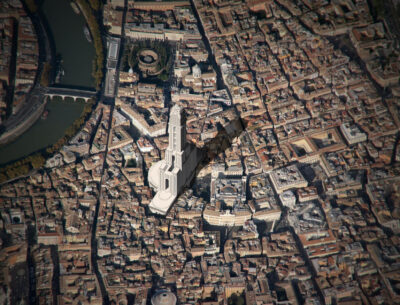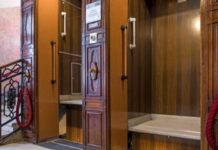The tallest building in the world. It was meant to be the headquarter of Italian Parliament, a hotel with conference and meeting rooms, a library, massive sports facilities and a telecommunications center – even an excellent astronomical observatory. Where? In the historical center of Rome.
ETERNALE, the WORLD’S TALLEST SKYCRAPER that never was in ROME
# The monster construction that would make the history in Rome
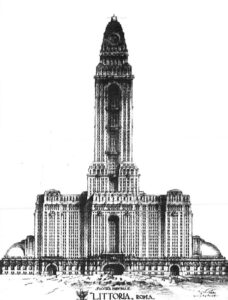
La Mole Littoria
If you’re thinking we are here to tell you about the new record at City Islands, take a few minutes to read this incredible story, involving a visionary architect who conceived a monster building project called the “Eternale”.
An ambitious Milanese architect emigrated to South America, Mario Palanti, made his fortune building the tallest skyscrapers in Montevideo and Buenos Aires. His abroad success made out of him a man so full of himself to present Benito Mussolini a shameless project that was to change the skyline of the Eternal City forever.
# The building that would eternalize the Fascist era
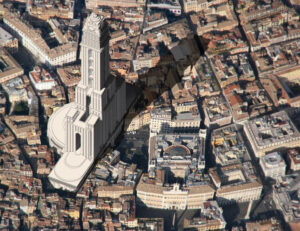
Il progetto fuori contesto
There is often a strange link between architects and dictators: Palanti has gone along with Mussolini’s self-esteem, bringing him as a gift an Argentinian horse and the project for an enormous skyscraper: 330 meters high (1.080 feet) and 70,000 square meters (more than 750k squared feet) wide, to be built in the center of Rome – “somewhere between Palazzo Chigi and the Tiber” – and covered with millions of square feet of white Carrara marble.
The name chosen was the Eternale, supposed to «celebrate an endless Fascist era in the Eternal City» and perhaps give Palanti the reputation of new Bernini or Bramante. If the grandeur of the idea is undeniable, yet it was matched only by its own failure.
# The anti-Architecture: a project out of Rome context
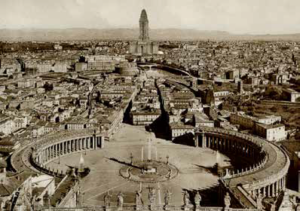
Palanti didn’t know Rome, and had no idea that such a project would require the demolition of half a district, even Palazzo Chigi (Italian Parliament site) itself. He was obsessed with the possibility to design the tallest building in the world, in one of the most highly populated areas on the planet.
He appeared in 1924 at a design exhibition in Palazzo Chigi, and captured Mussolini’s imagination with a project that curiously resembled both the skyscrapers of the dreaded United States and some of the ugliest public buildings in the Soviet Union, in a time when politics were glorifying Italian magnificence at all costs.
Basically, the project had no commercial purpose, it was designed to ingratiate itself with the regime and to appease that sense of inferiority that every dictator has always suffered from. Mussolini agreed with a lot of the basics of Palanti’s proposal, going deep into almost every detail. Although Palanti had never really comprehended the feasibility of the Eternale, he showed the audacity with which the palace was to rise: a brochure full of utopian renderings, the expectation that exposing all that white Carrara marble to the sun would make it visible from several miles away, whilst pleasing the dictator just enough to earn his confidence.
Mussolini signed the guest book with a dedication: “Per la Mole Littoria, Alalà“, consecrating the palace and giving the creature a name.
# Worldwide reactions

New York Times
The exhibition at Palazzo Chigi, organized to promote Italy and the genius of Italians, is also well covered by the international press. A few days later, the Mole Littoria was on the front page of the New York Times, highlighting the competition with NYC skyscrapers. In his review in the Deutsche Bauzeitung, Adolf Platz defines this project as a «mortal sin, against which world Christianity should rebel». Stadtebau magazine sticks in by talking about the “rape” of Rome, while the Los Angeles Times concludes that the building would make Rome «an irritating city».
Meanwhile, Palanti earned the notoriety he was looking for. Initially, Mussolini’s pride and fascination with Italy shone through thanks to the Milanese architect, but when the work’s feasibility was criticized, or the imagination went as far as to foreseeing Rome’s skyline being disfigured by the Mole Littoria overhanging St. Peter Dome, Palanti turned into the ideal scapegoat to blame Mussolini’s arrogance.
# What did the Italian Archi-stars of the time say?

La Mole Littoria
Much like its German twin, the Fascist establishment naturally had a very clear idea of how to redesign places, in order to leave an enduring mark in the history of architecture. Entire districts of all cities were completely redesigned.
One the one hand, it is easier to think that the regime’s favorite Archistars felt threatened by the construction of the Mole Littoria, – which would shadow over the entire city of Rome – but on the other hand, they also understood that, in the Eternal City, such a building would represent complete madness, starting from the renderings. Marcello Piacentini, who is remembered as the number one Archistar of the Fascism, rejected the idea with a judgment that sounded like a master plan: «No skyscraper will share the same sky as the Milan Cathedral or The Dome of Michelangelo at St. Peter’s. No skyscrapers in Italy, nowhere».
# Lowering the Mole seems to be a solution
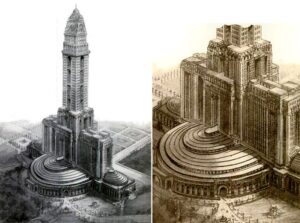
la Megastruttura
While they were trying to convince an enthusiastic Mussolini to give up to Eternale for reasons of all-round sustainability, Palanti was kindly invited to lower… His ambitions. He redesigned the tower with ever decreasing heights. From the initial 330 meters, it descended to 300m. (980 ft.), then 145 (475 ft.) all the way down to 80 meters (262 ft.).
In the meantime, in Genoa, Piacentini had built the first tower to top 100 meters (328 feet) in height. Not having produced anything significant yet, Palanti stopped being endorsed by Mussolini, the only one who, until then, had understood his genius.
Palanti participated in tender to build a Littorio Palace near the Basilica of Massenzio, but failed to win.
# No one will ever talk about it again
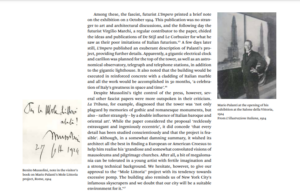
Parte del saggio
The world was then involved in other, much heavier endeavours. The Mole Littoria (or the “Eternale”) had been forgotten, since the Italian establishment was busy on other, much more delicate fronts.
Approximately in 2014, an American architect, Furman, found paperwork by an architectural historian at Brown University in Providence, CT, entitled “A Skyscraper for Mussolini”. The author was Dietrich Neumann, and it reported the timeline of a project about the world’s tallest skyscraper. Therefore, Furman decided to put it into context, resorting to study the singularity of the Eternale and the Italian capital in Rome.
Furman gives a very appealing definition of Rome, celebrating it as “the contemporary city in excellence, an urban version of the internet, a place where the analogical-whole history of society, architecture, politics, literature and art coalesce into a space so intense and delimited that they collapse under the enormity of their own mass into a singularity of human endeavour“.
In light of what Palanti could have arranged with Mussolini’s complicity, today these words make us appreciate the effort spent in order to make the regime desist from the unhealthy idea of competing with the height of St. Peter’s Dome.
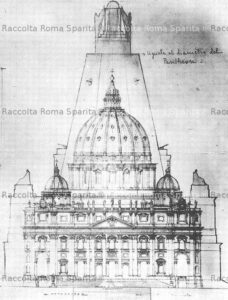
Mole v.s. Cupola
To be completely honest, all those who have tried to challenge St. Peter’s Dome, or rather its highness, have come to a bad end (just like Albert Speer did). Perhaps His Majesty “The Dome” is simply asking for respect and attention.
Sources: Dietrich Neumann “Skycraper for Mussolini” Free download https://www.academia.edu/30330778/Neumann_Skyscraper_for_Mussolini_AA_Files_2014_pdf
And https://www.archdaily.com/565598/mario-palanti-designer-of-rome-s-skyscraper-that-never-was
And https://www.milanocittastato.it/archistar/l-eternale-il-grattacielo-piu-alto-del-mondo-che-si-voleva-costruire-a-roma/
LAURA LIONTI


